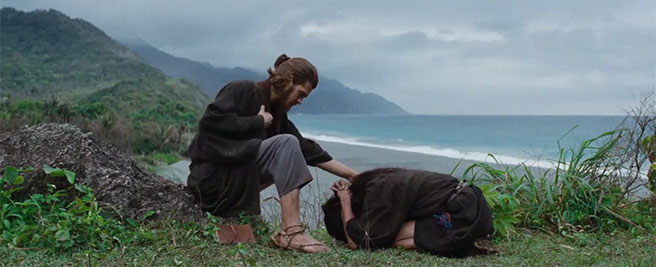By Mark Saldana
Rating: 4 (Out of 4 Stars)
Director Martin Scorsese comes from a Catholic, Italian-American, New Yorker upbringing, and this influence on his life definitely resonates in all of his films. From Mean Streets to The Last Temptation of Christ, and especially in his new film Silence, Scorsese has tackled the themes of faith and humanity’s dilemma when applying it to real world situations. As a filmmaker who utilizes this theme in so many of his films, it is, without a doubt, appropriate that he should adapt a novel that deals heavily with the subject. Based on the novel by Japanese author Shūsaku Endō, Silence may be Scorsese’s most powerful and challenging movie that examines the Catholic concept of faith and the purpose of missionary work, but also explores the problems of religious intolerance and cultural clash. Endō’s story and Scorsese’s adaptation of it do not offer easy answers or solutions (as there are none), but rather presents the quandary, leaving it open for pondering and discussion.
During the seventeenth century, two Portuguese Jesuit priests volunteer to seek out the truth behind the disappearance and rumored apostasy (defection) of their teacher Father Cristóvão Ferreira (Liam Neeson). Father Ferreira had traveled with other priests and monks to do missionary work in Japan in hopes of converting native people to Catholicism. However, the Japanese government and Buddhist leaders during this period treated missionaries and their converts with great hostility, forcing them to practice and convert underground. Priests and their congregations, if caught, were often tortured or even executed if they refused to renounce their beliefs. Fathers Sebastião Rodrigues (Andrew Garfield) and Francisco Garupe (Adam Driver) travel to the last known location of their mentor and must face some trials of their faith and beliefs to discover the hard truth.
Director Martin Scorsese and screenwriter Jay Cocks have taken an acclaimed and respected novel and adapted it into a beautiful, powerful, and sometimes gut-wrenching film that could even challenge the faith of the most devout Catholics and Christians. The story is fictional, but based on historical events. Once again, Scorsese dives head first into the trying nature of the real world on faith and beliefs and tortures his protagonist to the breaking point. Endō, Cocks, and the director offer thoughtful and meditative insights into and critiques of Catholicism, Buddhism, and religious persecution. If certain films are food for thought, then Silence is a massive feast for introspection.
The movie is rather dense (in a good way) and not particularly quick and easy to devour. Even as I write this review, I still have much more to consider and process, regarding its subject matter. I may even need to revisit the film a few more times to have a more complete opinion on it. Still, I have a deadline and not a lot of time to this. So, my review will have to be based on my initial reactions which are obviously quite positive. The fact, that a movie can affect me in this way, fueling my thoughts and emotions in some seriously philosophical ways, is the main reason why I have given this film such a high rating.
That isn’t to say that Scorsese’s presentation of the material isn’t superb, though. Working with extraordinary cinematographer Rodrigo Prieto (The Wolf of Wall Street, Biutiful), Scorsese has created an absolutely gorgeous vision of seventeenth century Japan, highlighting all of its natural beauty, to counter the darkness that can exist within the hearts of people. Once again Scorsese works with his favorite editor Thelma Schoonmaker who, as usual, delivers exceptional work in seamlessly piecing everything together. Considering that this isn’t Scorsese’s usual type of film, the movie requires a more subtle and subdued score, and Kathryn and Kim Allen Kluge deliver some lovely and sublime work.
The movie also features some wonderful performances by the cast, especially Andrew Garfield who portrays the gentle, innocent, and earnest heart of the story. Garfield and the writers excellently develop the character and one can only feel his pain, frustration, and pressure as his faith and beliefs are tormented by his challengers. Of the Japanese cast members, Shinya Tsukamoto (Mokichi), Yōsuke Kubozuka (Kichijiro), and Issei Ogata ( Inoue Masashige) perform exceptionally in their roles. Actors Adam Driver and Liam Neeson also offer outstanding work in their roles.
Now as extraordinary as I found this film to be, I am absolutely certain some people will be put off by the length of the film, the deliberate pacing, and the lack of action in it. This isn’t a Scorsese gangster film. It isn’t meant to be fast-paced, but more pensive and philosophical. This movie isn’t meant for those with short attention spans, but for those willing to think and even have some of their conventions and beliefs challenged. It is not an easy and entertaining journey, but one that promotes intelligent and critical thinking. This movie’s style has much more in common with the works of Kurosawa and Ozu, than it does with most of Martin Scorsese’s previous films, with the exception of his faith and spiritually themed films The Last Temptation of Christ and Kundun. In fact, this completes a trilogy of sorts with those previous movies. If people keep these things in mind and still wish to experience this motion picture, then chances are they too will be as moved as I am.
